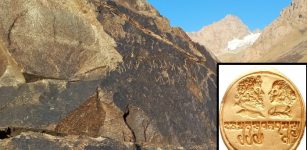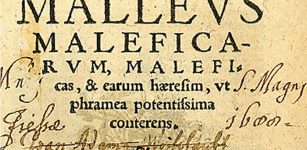Goddesses Of Fate And Destiny In Greek, Roman And Slavic Mythologies
A. Sutherland - AncientPages.com - An Italian humanist philosopher of the early Renaissance, Giovanni Pico della Mirandola (1463-1494), said that the human being is the master of his own life because human nature is a repository of instruments by which each individual can shape their life.
Rodzanice, narczniki, sudiczki - in the Slavic religion, invisible spirits or deities of fate. Generally mentioned in number three, but sometimes mentioned in number four, five, seven or even nine, of which one was "queen". Image credit: Marek Hapon, 2015 - CC BY-SA 4.0
However, those who oppose this belief say that human life results from fate's action - the final and irreversible will of the higher powers. There is no choice; fate is unavoidable, and it is simply our destiny, followed by the end of everything, which means - death.
Throughout the ages, myths and legends about fate have reflected our beliefs. People have often wondered about fate and its power.
The idea of a person's fate being spun was widely known in ancient Europe.
Three mythological goddesses known as "Fates" (with many names in respective languages) represent a common motif in European beliefs. Ancient people respected the idea of a person's fate being spun by divine beings.
According to Norse beliefs, the Norns were responsible for fate. They spun the thread of life at the roots of the World Ash, Yggdrasil.
"The Parcae," ca. 1885) by Alfred Agache. Image via wikipedia
Greek myths and legends make it clear that our attempts to outmaneuver an unavoidable fate are pointless. To the Greeks, fate and its influence on human life were of great concern, and countless myths and texts describe them as ugly older women, sometimes with disabilities.
Their fate goddesses were the Moirai/Moerae (sometimes called 'daughters of the night'), who sprang for each mortal. It is said that they were concerned with death but later began to decide what must happen to individuals.
They may have originated as birth goddesses, also concerned with death, but they later acquired their reputation as agents of destiny and those who control the Threads of Fate.
The Moerae sisters are known as Clotho ("the spinner"), who spins the thread of life, Lachesis ("the allotter or 'drawer of lots'), who assigns each person's destiny and Atropos ("the inevitable"), with scissors in her hands, decides when to snip the thread of life at its end.
They were worshipped as goddesses, and it is said that brides in Athens offered them locks of hair, and women swore by them. The Moirai were independent, and Zeus and other gods, as well as men, had to submit to them.
In Roman mythology, the Parcae (the equivalent of the Moirai) were the female goddesses of destiny. They were usually depicted as women weaving a tapestry covered with men's destinies.
Like the Norse and Greek goddesses of fate, they exercised the same arts. One was busy spinning the yarn, another was drawing out the thread, and another was cutting it.
The three Parcae sisters - Nona, Decima, and Morta - controlled the thread of life of every mortal and immortal from birth to death. Both gods and humans feared their unlimited power.
In the mythology of Slavic people, the Sudice (known after different names among the ancient Slavs) were responsible for the fates and destiny of humanity. They judged and meted out fortune and fatality.
They could appear as a single goddess or as three sisters at the birth of a child, just in time, when a newborn's fortune was foretold and destiny was sealed. The oldest of the sisters spoke last; her words could never be revoked or contradicted.
Fate was determined for all, regardless of whether they were good or wrong.
The Sudice were beautiful old women with white skin and white clothes. They wore necklaces of gold and silver, white kerchiefs, and sometimes carried lit candles. The ancient Slavs made offerings to them in the form of bread, candles, and salt.
Written by – A. Sutherland AncientPages.com Staff Writer
Updated on March 28, 2024
Copyright © AncientPages.com All rights reserved. This material may not be published, broadcast, rewritten or redistributed in whole or part without the express written permission of AncientPages.com
Expand for referencesReferences:
Gieysztor Aleksander, Mitologia Słowian
Cotterell, A. A Dictionary of World Mythology
Monaghan P. Encyclopedia of Goddesses and Heroines
Tanner, Ross. Greek Mythology:
More From Ancient Pages
-
 Rare 2,500-Year-Old Scythian Bone Sceptre Discovered In Bulgaria
Archaeology | Oct 3, 2023
Rare 2,500-Year-Old Scythian Bone Sceptre Discovered In Bulgaria
Archaeology | Oct 3, 2023 -
 Ishtar Gate, The Eighth Gate Of The Inner City Of Babylon
Civilizations | Sep 6, 2015
Ishtar Gate, The Eighth Gate Of The Inner City Of Babylon
Civilizations | Sep 6, 2015 -
 Teotihuacán: Enigmatic Birthplace Of The Gods And Its Obscure History
Civilizations | Jul 26, 2016
Teotihuacán: Enigmatic Birthplace Of The Gods And Its Obscure History
Civilizations | Jul 26, 2016 -
 Pitted Ware Culture – Neolithic Scandinavians Used Skin Boats To Trade And Travel Across Large Distances
Archaeology | Sep 11, 2024
Pitted Ware Culture – Neolithic Scandinavians Used Skin Boats To Trade And Travel Across Large Distances
Archaeology | Sep 11, 2024 -
 Neanderthals Lived Much Longer In Gipuzkoa Than Previously Thought
Archaeology | Feb 10, 2023
Neanderthals Lived Much Longer In Gipuzkoa Than Previously Thought
Archaeology | Feb 10, 2023 -
 Mysterious Nine Worlds Of Yggdrasil – The Sacred Tree Of Life In Norse Mythology
Featured Stories | Mar 8, 2017
Mysterious Nine Worlds Of Yggdrasil – The Sacred Tree Of Life In Norse Mythology
Featured Stories | Mar 8, 2017 -
 Bizarre Towering Pillars Of Externsteine: Myths, Legends And Sacred Rituals From Times Long Gone
Civilizations | Jan 7, 2017
Bizarre Towering Pillars Of Externsteine: Myths, Legends And Sacred Rituals From Times Long Gone
Civilizations | Jan 7, 2017 -
 Mystery Of Biblical Noah’s Strange Connection With Red-Skinned Giants And The Watchers – Celestial Secrets – Part 2
Biblical Mysteries | Jan 28, 2021
Mystery Of Biblical Noah’s Strange Connection With Red-Skinned Giants And The Watchers – Celestial Secrets – Part 2
Biblical Mysteries | Jan 28, 2021 -
 Unexplained Mystery Of The Untraceable Stone-Throwers – Strangeness In Australia And New Zealand – Part 2
Featured Stories | Nov 13, 2019
Unexplained Mystery Of The Untraceable Stone-Throwers – Strangeness In Australia And New Zealand – Part 2
Featured Stories | Nov 13, 2019 -
 Babylon Excavation Uncovers 478 Artifacts, Including Cuneiform Tablets and Seals
Archaeology | Oct 17, 2024
Babylon Excavation Uncovers 478 Artifacts, Including Cuneiform Tablets and Seals
Archaeology | Oct 17, 2024 -
 Secrets Of Nanomaterial From The Middle Ages Examined By Scientists
Archaeology | Oct 11, 2022
Secrets Of Nanomaterial From The Middle Ages Examined By Scientists
Archaeology | Oct 11, 2022 -
 Enigmatic Ancient ‘Unknown Kushan Script’ Deciphered By Scientists
Archaeology | Jul 13, 2023
Enigmatic Ancient ‘Unknown Kushan Script’ Deciphered By Scientists
Archaeology | Jul 13, 2023 -
 Genetic Fingerprints Of Unknown Species Discovered In Human DNA
Human Beginnings | Dec 31, 2019
Genetic Fingerprints Of Unknown Species Discovered In Human DNA
Human Beginnings | Dec 31, 2019 -
 Leprechaun: One Of The Most Famous And Powerful Creatures Of The Irish Faerie Folk
Celtic Mythology | May 8, 2016
Leprechaun: One Of The Most Famous And Powerful Creatures Of The Irish Faerie Folk
Celtic Mythology | May 8, 2016 -
 Ancient Europeans Ate Seaweed And Freshwater Plants – Evidence Found
Archaeology | Oct 17, 2023
Ancient Europeans Ate Seaweed And Freshwater Plants – Evidence Found
Archaeology | Oct 17, 2023 -
 Mysterious Relics Can Retrieve Leonardo da Vinci’s DNA And Provide New Information About The Great Renaissance Man
Archaeology | Apr 22, 2017
Mysterious Relics Can Retrieve Leonardo da Vinci’s DNA And Provide New Information About The Great Renaissance Man
Archaeology | Apr 22, 2017 -
 Ancient Knowledge About Horse Taming Is Rewriting Our Picture Of The Past
Archaeology | Jan 27, 2022
Ancient Knowledge About Horse Taming Is Rewriting Our Picture Of The Past
Archaeology | Jan 27, 2022 -
 How The Handbook ‘Hammer Of Witches’ And Then-Existing Networks Inspired Europe’s Witch Craze
Social Sciences | Oct 10, 2024
How The Handbook ‘Hammer Of Witches’ And Then-Existing Networks Inspired Europe’s Witch Craze
Social Sciences | Oct 10, 2024 -
 Vindolanda Treasures: Rare Roman Cornu Mouthpiece – Instrument of War – Uncovered
Archaeology | Sep 24, 2022
Vindolanda Treasures: Rare Roman Cornu Mouthpiece – Instrument of War – Uncovered
Archaeology | Sep 24, 2022 -
 Why Did We Abandon Roman Numerals?
Ancient History Facts | Apr 25, 2019
Why Did We Abandon Roman Numerals?
Ancient History Facts | Apr 25, 2019


